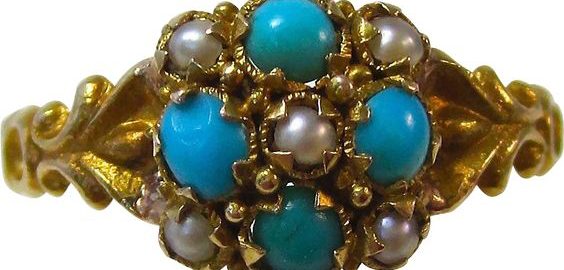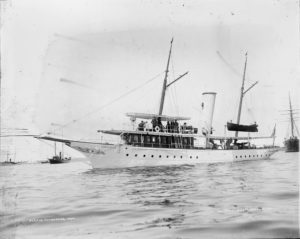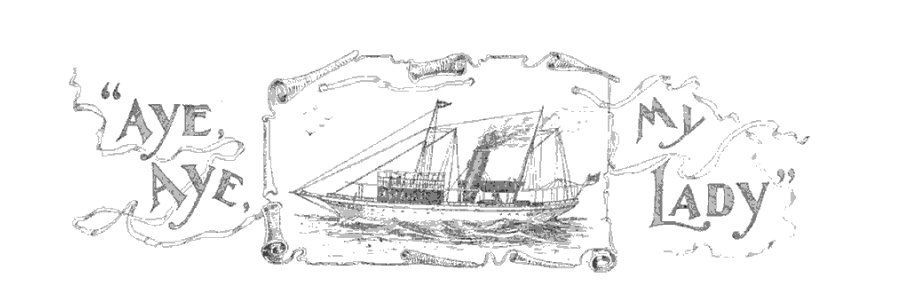Victorian Wedding Rings

Victorian Wedding Rings
Today’s research reading on Victorian wedding rings–and engagement rings–comes to you from pages 48-49 of The Jewelers’ Circular and Horological Review, Vol XV, No. 2, March 1884. I’ve reached a point in my current novel draft where the hero believes he has reason to purchase an engagement ring, so of course I went looking to make sure that was a thing in the 1890s, and to see what sort of ring he might buy. Something with just pearls, I think–he’s not quite sentimental enough to spring for the turquoise and seed pearl forget-me-not!
Buying Wedding Rings.
A shy young man went into a Broadway jeweler’s store, so says a local reporter, and looked at gentlemen’s rings, fingering them and asking questions about them, and yet appearing to take only a forced interest in them. The jeweler’s clerk whispered to a bystander, “By-and-by he will come around to the wedding or engagement rings. That is what he has come after.” Sure enough, the young man presently pointed to a tray of flat gold band rings. “What are they for?” he inquired. The clerk said that they were merely fancy rings, worn by ladies and gentlemen, and that some folks bought them for wedding rings. The shy young man tried two or three on his little finger, and, finding one that would not quite go over his knuckle, said, “Give me this one. How much is it?”
“It’s five dollars,” said the clerk, “but if you want a wedding ring I would advise you not to buy it. Every now and then we sell them to people who insist upon having them, but as soon as they find out the fashion they come back and have them melted up and rolled up into this old-fashioned round form. The only wedding ring is the round ring, plain and simple.”
“Gimme a round one, then; same size as this.”
He got one and went away. The clerk laughed, and said he could tell when a young man wanted a wedding or engagement ring every time; though sometimes they ask to be shown clocks, bracelets, or anything rather than what they come for. Very many come right to the point, though they stammer and falter about it quite painfully. Others again ask frankly and boldly to see what they want. “There never has been a change int he fashion of wedding rings,” said the clerk; “the plain round gold ring has always been the only correct thing. Men sometimes choose other kinds, but women never make that mistake.”
“Do women choose their own wedding rings?”
“Oh, very often. Frequently they come in alone, fit a ring to the right finger and leave it for the prospective bridegroom to pay for. Sometimes they pay for it and take it away, and of course the young man reimburses them. Quite often, too, the brides come in with their mothers. Very serious and grave the mothers are, and show neither timidity nor sentiment. They ask for wedding rings, they look them over, buy one, and go away. Irish and German girls often bring their lovers as well as their mothers. There is not a funnier sight in the world than to see a clumsy fellow hanging behind and looking unutterably foolish while his sweetheart and her mother discuss the purchase. They pay no attention to him until they come to the final selection. Then they tell him how much is to be paid and he pays it and they all go out. Irishmen are apt to be close buyers. They will scarcely ever buy anything without knocking something off the price, but no Irishman ever haggles over a wedding or engagement ring. It does not matter if the wedding ring he chooses comes as high as nine dollars. He pays the price without a murmur.”
“Many foreigners, particularly Germans, exchange wedding rings. The bride pays for the groom’s ring and vice versa. At the altar they exchange rings. They come in together to buy them.”
“What is the fashion in engagement rings?”
“Oh, there is no fashion in them particularly. Any pretty ring set with small stones does for the purpose. Turquoises and pearls are popular just now, and so are pearls by themselves. Diamonds are the rage with people who can afford them, and from that the precious stones range downward in price to amethysts. Engagement rings cost from $15 to $150; wedding rings from $5 to $15. Very many persons have initials, dates, or mottoes engraved in their wedding rings. ‘Mizpah,’ or ‘Thine forever’ are favorites, but the commonest custom is to have merely the initials and date–‘J.S. to S.J., Nov. 11, 1883’–cut in the inner surface of the ring. Nothing is engraved in engagement rings. The manner of wearing them has changed, however. They used to be word on the index finger of the left hand, you know, but the ladies think that a little too much of an advertisement nowadays, and they wear them on the third finger of the right hand. That finger of the left hand is still the one on which wedding rings are worn.”
On page 39 of the same issue, you will find an article on Electric Jewelry! Perhaps I’ll find a way to work that into a future story.
 For my historical romance in progress, I have a scene set on a steam yacht. I went looking for info about such vessels and settled upon a particular historical boat to use as a model in the scene – the Dungeness, owned by Mrs. Lucy Carnegie, widow of Pittsburgh steel magnate Andrew Carnegie’s brother Thomas.
For my historical romance in progress, I have a scene set on a steam yacht. I went looking for info about such vessels and settled upon a particular historical boat to use as a model in the scene – the Dungeness, owned by Mrs. Lucy Carnegie, widow of Pittsburgh steel magnate Andrew Carnegie’s brother Thomas. Aye, Aye, My Lady
Aye, Aye, My Lady